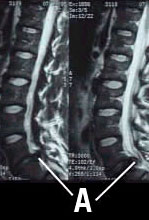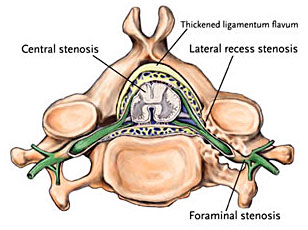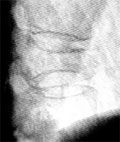Back & Neck Conditions
Spinal Arthritis
Over 90% of people experience at least one episode of severe lower back pain at some point in their life. Fortunately, 80% of these episodes resolve spontaneously (without surgery) within two weeks and 95% within one month. During this time, treatment consists of symptomatic care with anti-inflammatory pain medications, activity modification, and/or Physical Therapy. We ask that patients do not engage in activities that are painful, but it is also important to stay as active as possible. If back pain becomes chronic, other treatments (such as steroid injections and surgery), are considered on a case-by-case basis.

Spinal Arthritis
Most arthritis of the spine is “degenerative” in nature (also known as “Degenerative Disease” or “Osteoarthritis”). Often, these degenerative changes are part of the normal aging process, but they can also happen earlier due to heavy stresses placed on the spine. Osteoarthritis of the spine can cause stiffness and pain with activities. In most cases, these symptoms can be treated successfully with anti-inflammatory pain medication and Physical Therapy. If symptoms are chronic and severe, some people may also benefit from steroid injections into the joints of the spine.Occasionally, degenerative changes can contribute to the pathologic conditions of spinal stenosis, myelopathy, disc herniation, or spondylolisthesis.

Myelopathy
Myelopathy is a condition caused by excessive pressure being placed on the spinal cord. This condition often occurs in the neck and is caused by degenerative changes (arthritis) and/or herniated discs. Early myelopathy manifests itself as difficulty with fine motor tasks, such as using keys and picking up objects, and difficulty with balance and changes in the way a patient walks. As myelopathy worsens, many patients experience numbness and tingling and lose strength in their arms and legs. In its most severe form, patients become so weak they have extreme difficulty standing and walking.
The treatment for this condition is surgical decompression. This means that the structures squeezing the spinal cord are removed. Although surgery usually results in a cure, often the lost strength is not fully restored.

Scoliosis
Scoliosis is a curvature of the spine that is caused by the vertebral bodies rotating on one another. In addition to the cosmetic deformity that results, this rotation can be painful in some cases and result in pinched nerves (radiculopathy) in others. If the curve is small and the patient is not having symptoms, scoliosis is treated with observation in adults and observation or bracing in children. If pain or radiculopathy occur, they are usually treated medically. If curves reach a certain magnitude, then they are deemed “progressive,” and surgical correction is recommended.

Spinal Stenosis/Neurogenic Claudication
Spinal stenosis refers to narrowing of the spinal canal, which can cause various symptoms due to compression of the spinal cord when the condition becomes severe. Stenosis (narrowing) usually occurs due to age related changes of the spine.
Neurogenic Claudication refers to pain and weakness in the legs, sometimes with numbness and tingling, that occurs when the spinal nerves in the lower back are compressed. Symptoms often appear after standing or walking for awhile, and are typically relieved by leaning forward.
This condition can sometimes be managed conservatively with medications to treat “nerve pain” and Physical Therapy to maintain strength. Some patients may require surgical decompression (relieving the pressure on the nerves), which usually results in relief.

Disc Degeneration, Bulging Discs, and Herniated Discs
“Bulging” discs refer to those that are degenerated as part of spinal arthritis – this condition results in the disc losing its shock-absorbing properties, and flattening out. As this occurs, the disc tends to extend beyond the bones of the spine slightly (bulging out).
A “herniated” disc is one that has extends further into the spinal cavity, and often occurs suddenly due to a traumatic event. This can happen as the result of “disc degeneration,” as the walls of the disc become weaker and do not hold the disc in place as well.
Both bulging discs and herniated discs can sometimes compress spinal nerves, depending on their location and size. When this happens, the patient may experience symptoms of radiculopathy. Sometimes, the bulging or herniated discs can cause pain themselves, which is typically felt deep in the back. This type of pain can be treated with steroid injections, or surgery may be considered.
Spondylolisthesis
Spondylolisthesis occurs when one vertebral body slides forward on another. This often occurs due to age-related “degenerative” (arthritic) changes in the spine. Treatment depends on how much the vertebral body is displaced. When this is mild, spondylolisthesis can usually be treated conservatively. If conservative treatment fails, or if the slippage is severe, surgical fusion is considered.
Radiculopathy & Sciatica
When an inter-vertebral disc herniates (slipped disc), it sometimes compresses a spinal nerve, resulting in radiculopathy. Radiculopathy is characterized by burning or shooting pain into the arms or legs. When this type of pain occurs in the legs, many people refer to this type of radiculopathy as “sciatica.” In 90% of cases, radiculopathy resolves without surgery within 6 months. Symptoms can be treated with anti-inflammatory pain medications, medications for “nerve pain,” or steroid pills. Some patients obtain relief after an injection of steroids into the spinal canal (epidural steroid injection). If symptoms persist for 8 weeks or longer, a patient can consider having the offending disc removed surgically.

Myofascial Pain
Myofascial pain refers to pain that originates from the muscles and connective tissues (fascia) in the body. This type of pain is very common, and can be worsened by certain patterns of holding the body when sitting or standing. Whiplash injury is a type of myofascial pain that occurs when a sudden jolt is experienced by the head and neck muscles.
Myofascial pain often feels deep and achy, but sometimes may feel sharp and have a spasm-like quality. Patients often report that pain is worsened by certain activities, but it is important to keep the muscles moving because it tends to become worse with inactivity. This type of pain is treated with anti-inflammatory medications and Physical Therapy. If the pain is severe, muscle relaxers and trigger point injections can be considered. Trigger point injections are done in the clinic and usually do not use steroid medication. This type of pain is not responsive to surgery.
Sacroiliac Joint Pain/Dysfunction
The sacroiliac joints are the places where the bones at the bottom of the spinal column join the bones of the pelvis on either side. These bones are attached by a series of ligaments, and the muscles of the buttocks attach close to the sacroiliac joint. It is very common to have pain originating from the sacroiliac joint, and this occurs due to both arthritis as well as to “dysfunction” of the joint, with the bones being slightly out of alignment with each other. This type of pain is usually treated with a combination of steroid injections and Physical Therapy, as well as anti-inflammatory medications. This type of pain is not responsive to surgery.
